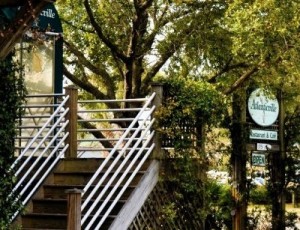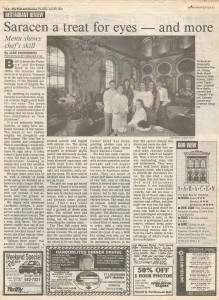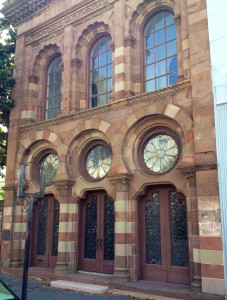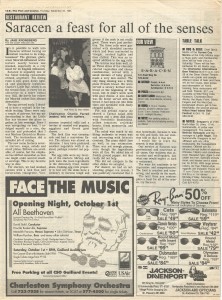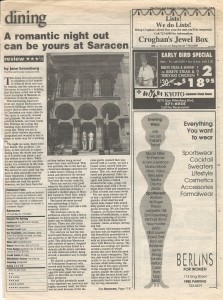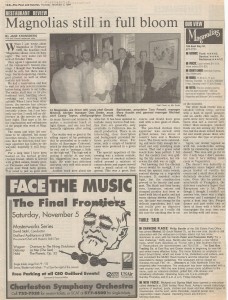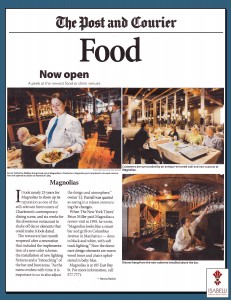Flashback
We love our local restaurant community and have been keeping our fingers on the pulse for 70 years. One of our favorite past times is to read and collect the restaurant reviews found weekly inside The Post and Courier. Going back to the days of Peter Herman and Jane Kronsberg, we have hundreds of them that we love reading every so often and reliving some of our city’s past as it relates to food.
Since we love reading them so much, we thought it would be fun to share with our customers and community friends. As part of our new website redesign, we are excited to have a special section dedicated to showcasing the old reviews alongside a “where are they now” report. We will select a new review every week and post it. We will also have a fun update on the restaurant, the chef or even the menu as it is today as part of the recap. It is part of our “Flashback Fridays” and we hope you will enjoy.
FlashBack Fridays: Then and Now at 2063 Middle Street 7.18.14
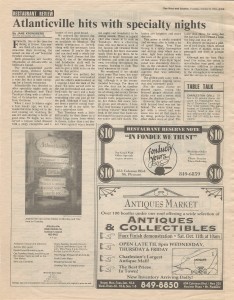 Atlanticville, located at 2063 Middle Street, was a Sullivan’s Island institution for 22 years. Now only a memory, we wanted to revisit the reputation of the restaurant and explore its lasting impact on the Sullivan’s Island culinary scene by digging up its review and reaching out to the new residents of 2063 Middle Street.
Atlanticville, located at 2063 Middle Street, was a Sullivan’s Island institution for 22 years. Now only a memory, we wanted to revisit the reputation of the restaurant and explore its lasting impact on the Sullivan’s Island culinary scene by digging up its review and reaching out to the new residents of 2063 Middle Street.
The Post and Courier’s Food Critic Jane Kronsberg reviewed the restaurant on October 9, 1997. Highlighting the establishment’s view and comfortable porch seating, Kronsberg noted the pleasantries of outdoor dining in Charleston during the fall. Atlanticville set itself apart from its island neighbors by steering away from the typical overly casual beach atmosphere and unsophisticated menu. Upon opening, the late Chef Phil Corr was at the helm. He took a risk gambling on the notion that beachgoers would find respite from sun and sand inside his relatively upscale accommodations and be drawn to his integration of locally sourced ingredients.
It was a wager that worked. A sister publication of USA Today, The 10Best wrote, “Exceptional cuisine is the hallmark of this relaxed Sullivan’s Island restaurant, and awards rain constantly upon its chef and kitchen.” General Manager Andrew Harris stepped in for the last part of Atlanticville’s two-decade reign and continued to honor Corr’s culinary passion.
In 2012 the restaurant closed for what was to be a period of renovation; however, it never reopened and shuttered for good later that summer. While Atlanticville may be closed for ever, it raised the bar on island cuisine, laying a foundation for further refinement of this culinary genre.
Not long after its closure, whispers of what would replace Atlanticville began to circulate within the industry, growing louder when the owner of Wild Olive Restaurant Group sought permitting for Sullivan’s Island. Soon enough, it was announced that Chef Jacques Larson and the Wild Olive Restaurant Group would open a new venture at 2063 Middle Street.
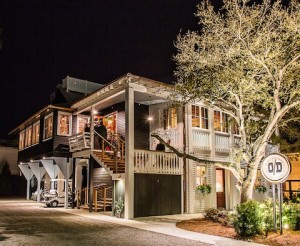 On March 19, 2014, The Obstinate Daughter opened for business. According to the restaurant’s website, the name comes from Revolutionary War history on Sullivan’s Island. In 1776, defenders of Fort Sullivan saved the island from British capture during the Battle of Sullivan’s Island. It was this act that “inspired a London political cartoon of the defiant defenders of Charleston: “Miss Carolina Sulivan, one of the obstinate daughters of America, 1776”.”
On March 19, 2014, The Obstinate Daughter opened for business. According to the restaurant’s website, the name comes from Revolutionary War history on Sullivan’s Island. In 1776, defenders of Fort Sullivan saved the island from British capture during the Battle of Sullivan’s Island. It was this act that “inspired a London political cartoon of the defiant defenders of Charleston: “Miss Carolina Sulivan, one of the obstinate daughters of America, 1776”.”
Calling itself a “Food Fort,” the restaurant boasts Southern cuisine with French, Italian, and Spanish influences. It is progressive in its offerings and business approach, seeking a Green Restaurant Certification. The Obstinate Daughter has decidedly upped the ante on island dining. And we’re not the only ones who think so. Writer Robert Moss in a write up for the Charleston City Paper noted the establishment has “the right formula to round out a revitalized beach dining scene.”
While Charleston and its surrounding islands are certainly in the midst of a culinary awakening, this current movement was surely sparked by the restaurants and chefs of yesteryear. One cannot deny that Atlanticville’s gamble may have incited the desire for more urbane fare on this barrier island.
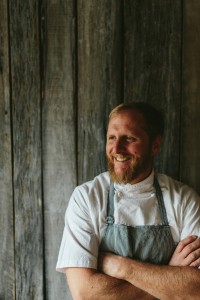 When asking Chef Larson about his influences for the new restaurant, we wondered if Atlanticville may have played a part.
When asking Chef Larson about his influences for the new restaurant, we wondered if Atlanticville may have played a part.
Larson: Having moved to Charleston in 1996, I was quite familiar with Atlanticville restaurant and more specifically, Phil Corr. Phil was a “chef’s chef.” His hard work ethic and passion for food mixed with a great sense of humor made him a local favorite. He was also an early advocate of sourcing things locally. After the sad loss of Phil to lung cancer, Andrew Harris took the torch at Atlanticville, and I would most certainly say that he embodied the same drive for hospitality excellence that Phil strove to achieve.
These factors have had a direct influence on what we set out to accomplish on Sullivan’s Island. Focusing on using local products, building genuine relationships with guests and delivering high quality food and service in a comfortable, yet polished setting. [This] is still the same goal at 2063 Middle St.
The Obstinate Daughter’s Revolutionary War-inspired motif reflects its revolutionary ideologies about beach cuisine. We hope this “Food Fort” defends its stay on Sullivan’s Island—much like its stubborn influencer, Miss Carolina Sulivan— for years to come, and that it continues to carry on so beautifully the hospitality and passion of the chefs and staff who came before.
FlashBack Fridays: Saracen’s Reviews 6.27.14
Saracen Reviews: April 22, 1992; September 22, 1994; and November 12, 1998
Saracen was well known for its lush interior, described on several occasions as a “feast for the eyes.” Located at 141 East Bay Street in Charleston, SC, the restaurant occupied the Farmer’s and Exchange Bank building, a structure equally known for its appearance and brush with fate.
Before Owner and Chef Charlie Farrell opened Saracen in 1990, the building served as office space for Sen. Fritz Hollings and was nearly demolished to make way for parking. Saved in 1970, the building was restored and added to the list of National Historic Landmarks in 1973.
The building’s architecture, Moorish and Spanish in style, is rare in the Holy City; this uniqueness nicely complemented the unexpected cuisine one would find inside.
Former Post and Courier restaurant critic Jane Kronsberg reviewed Saracen on three occasions, in 1992, ’94, and ’98, detailing a pleasant experience each time. The cuisine featured Mediterranean and Asian ingredients and was described as new American with Middle Eastern flavor. Like many restaurants of today, the menu at Saracen was small and changed regularly utilizing seasonal produce.
Highlights of the menu included dishes like “salmon three ways,” chilled beet and grapefruit soup, Thai fish cakes, shrimp and pork egg rolls, apple and potato crusted trout cake, and coffee-rubbed quail. Saracen presented unique dishes including Cioppino, an Italian-American fish stew, and quenelles, creamed fish or meat combined with bread crumbs and light egg binding, a dish not often served in American establishments.
Chef Farrell also infused Moroccan, Vietnamese, and Caribbean spices into his dishes creating a menu of eclectic offerings over the years.
The establishment’s second floor was home to Charlie’s Little Bar (named for Farrell) and echoed the Moorish architecture, luxury, and comfort of the first-floor dining area. Kronsberg reported that the Little Bar attracted big crowds out for late weekend nights.
The décor at Saracen, Kronsberg noted, provided a romantic atmosphere reminiscent of the mystery and magic conjured by stories of Arabian Nights. She described the restaurant as luxurious, glamorous, and “one of the best-looking restaurants around.” One last note, Kronsberg ranked Saracen’s decibel level at “quiet,” and in light of a recent Post and Courier report on restaurant noise, such a tranquil dining experience might be—like the Saracen—a thing of the past.
The building that housed Saracen for many years now stands vacant, hosting special events from time to time. We hope that a place this special and with so much history will once again come to life as some sort of amazing culinary gem for the city.

Limehouse Produce Flashback Fridays: Magnolias Review 6.6.14
Review Date: 11/3/1994
Magnolias is a mainstay of the culinary scene in downtown Charleston. For more than two decades, the restaurant has held its place as one of the city’s most prestigious establishments thanks to its distinct approach to traditional southern fare, unique wine program and unparalleled service. Critic Jane Kronsberg first reviewed Magnolias in 1992 and again two years later echoing the restaurant’s continued success, noting its progressive take on wine and steady stream of diners even midweek.
When speaking recently with Chef Drake and TJ Parsell, owner and president of Hospitality Management Group, we asked them to provide their thoughts on what has changed, what remains the same, and what keeps guests coming back year after year.
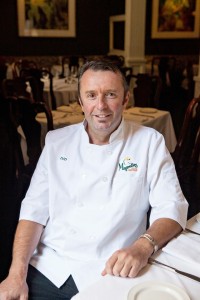
Parsell: As Magnolias approaches its 25th anniversary in 2015, guests continue to look to this staple for the original Southern charm they have come to know and love since it opened its doors. Magnolias’ continued excellence in providing diners timeless Lowcountry cuisine keeps visitors hungry to return. The consistency of Magnolias’ charming atmosphere and celebrated cuisine beckons locals and visitors in to this East Bay St. classic year after year.
One of the most notable consitencies from the early reviews is that of Chef Don Drake. A rarity in the culinary industry, Chef Drake has been at the helm for all but 2 of the 24 years Magnolias has been open, keeping the restaurant true to its southern roots.
Drake: My tenure at Magnolias is attributed to the Parsell Family. Tom & Suzie [Parsell] were great mentors—Suzie with her philanthropy and support of local events and Tom, sharing both his business and personal advice. He was like an older brother, and we had a lot of fun over the years (and he kept me out of trouble!). Now with TJ’s leadership, it seems like we haven’t missed a beat. We work well together and have great plans for the future. It would be really hard to work for another company—I think I’d just retire and go sailing.
Parsell: In this business, it’s all about consistency and quality in food and service. Drake’s tenure at Magnolias has eliminated many of the problems restaurant face with turnover, especially in upper management.
While consistency in staff, food and service have clearly served the establishment well, Magnolias recently underwent major renovations resulting in a new color palate and refreshed décor that underscores the restaurant’s prowess to endure.The reaction to the new space from diners and critics alike has been overwhelmingly positive.
Parsell: As the menu evolves with time, it was important to us to also adjust the design and atmosphere, providing the best dining experience for our guests. The space has been updated with a sophisticated look, but guests will still feel like they are in their favorite spot for world-class Southern cuisine.
Magnolias’ continued presence in the community has delivered a comforting and familiar dining experience for more than two decades, and we look forward to enjoying all that the restaurant has to offer for years to come.
Other notes:
- Kelly Franz, Chef de Cuisine, has been with the team for 11 years.
- The chicken livers, a guest favorite, have never been taken off the menu.
- Two featured oil paintings and several lithographs from Ron Goebel’s Magnolias Suite, commissioned by Tom Parsell for the opening of Magnolias in 1990 still remain in the restaurant.
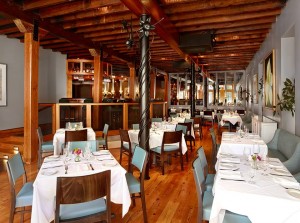
Limehouse Produce FlashBack Fridays: Hominy Grill review 1.31.14
 For the first review, we selected an old Charleston favorite—Hominy Grill. Well, it’s not that old. But it is one of Charleston’s most recognized and written about places. That’s because Chef Robert Stehling has done an outstanding job of defining a place that is truly southern and delicious and we are proud to see how far he has come over the years.
For the first review, we selected an old Charleston favorite—Hominy Grill. Well, it’s not that old. But it is one of Charleston’s most recognized and written about places. That’s because Chef Robert Stehling has done an outstanding job of defining a place that is truly southern and delicious and we are proud to see how far he has come over the years.
Here are some updates and comments from Stehling based on the original Peter Herman review.
Robert Stehling: Looking at the review, one of the most apparent things that has changed is the menu. Not saying it is all that different, we just don’t do some of the items any more. Items like the boneless pork chop, crab cakes, grilled breast of duck and pan-seared rib eye steak are gone. Those dishes did not really define who we were trying to be—we just felt like we had to have them. We also do not serve the chicken liver pasta dish even though people come in and beg us to bring it back.
We do serve the items that do represent us well—the shrimp appetizer but we now have two, one with pickled shrimp and one with pickled okra and country ham. We have the catfish and fried chicken and of course our desserts are still “terrific” as Peter states.
Hominy Grill also recently had a major renovation and added 25 seats outside and 20 outside, still keeping the outdoor setting, but opening it up more to see it from the street. The great thing about the house is that it required little renovations when Robert got the space after Tom’s (the restaurant that occupied the space before Hominy Grill) closed down. They only had to paint and the designer came in and recommended not to do much. When asked about the exterior, Robert shares the story about the selected mural:
RS: I knew of artist David Boatwright and loved the Rutledge Coffee & Cream sign on Coming and Spring streets. I knew I wanted him to do something similar and as anticipated, he created a memorable sign that really helps distinguish our brand.
When asked if David has ever had to repaint it, Robert shares that they have scrubbed the outside once, but he is confident David comes when they are closed from time to time to do touch ups.
The best part of recalling the Peter Herman review is Robert’s memory of the night of the review:
RS: Yes, I knew he was in. My parents were actually at dinner and Peter came by our table while we were eating. He told me he was writing the review and I was petrified. All I could do when I learned was try to remember all the stuff he ate!
He laughs when he looks back at some of the items he was served. Back then, Robert was still trying to figure out who he was as a restaurant and soon realized serving lentil salad and tuna cakes was not what he wanted to cook.
Well to us, he figured it out quickly and truly represents a quintessential Lowcountry place. Hominy Grill is a true staple in the Charleston culinary landscape and locals, out of towners and media flock to it as a “must go to” place. Robert has also been recognized in almost every major food media outlet and remembers the days people like the former New York Times food critic R. W. Apple, Jr. and Anthony Bourdain came to dine. It helped garner accolades like the coveted James Beard Foundation Best Chef Southeast award, an award only won by one other local chef before receiving it (Chef Louis Osteen). When asked about his favorite “celebrities to host” (aside from those listed above), he shares:
RS: I loved having Jimmy Buffett in, and Lou Reed and Ted Danson came nine times in three days. I finally came out the last time he was in and thanked him. When I really saw a major influx of visitors was after Rachael Ray tape her show “$40 Dollars a Day”. It was amazing how many people watch that show, Bourdain’s show, Man vs. Food and others.
As far as proudest moments:
RS: That people are so fond of the place. That we are an institution—a neighborhood place. It is what we always wanted to be.
His favorite dish on the menu:
RS: Shrimp & Grits, it has been part of the repertoire since the first days in the kitchen. It is so simple and just great food.
Fun Facts:
- The biggest renovation they did on the space was to the kitchen
- Before it closed, Tom’s had a banner on the side of the building that stated “worst food in town” after a bad review in The Post and Courier
- The original interior paint color was burgundy—now it is a starch white.

